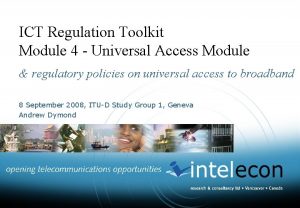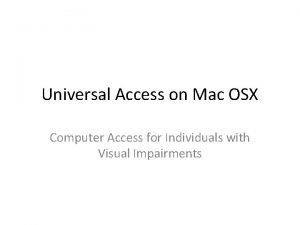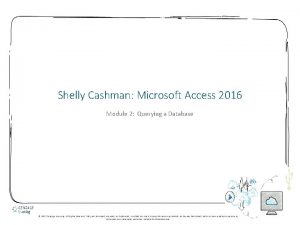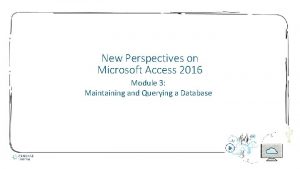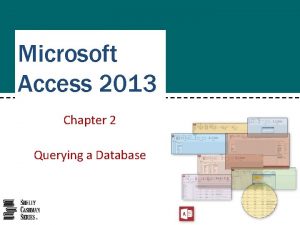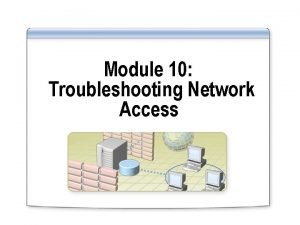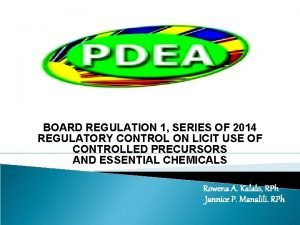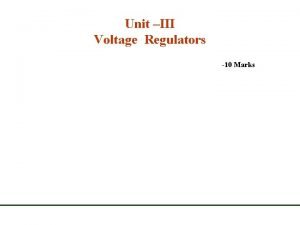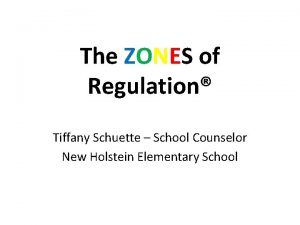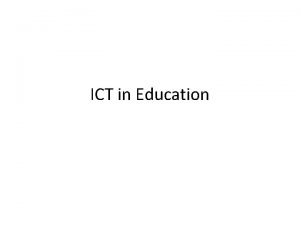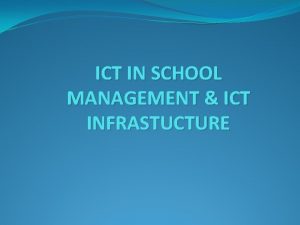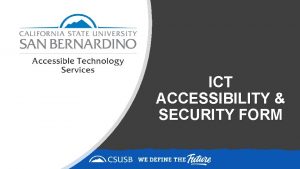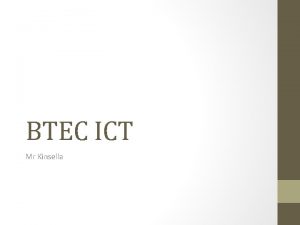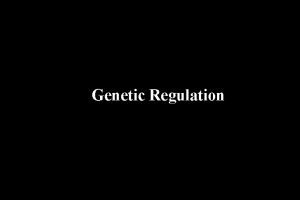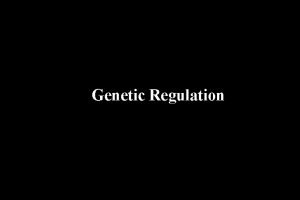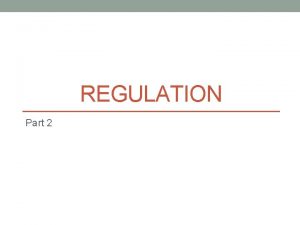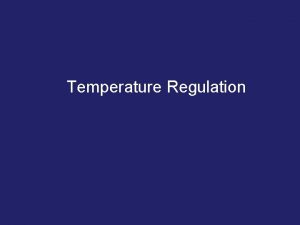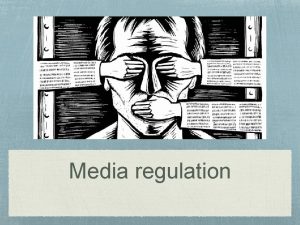ICT Regulation Toolkit Module 4 Universal Access Module




















- Slides: 20

ICT Regulation Toolkit Module 4 - Universal Access Module & regulatory policies on universal access to broadband 8 September 2008, ITU-D Study Group 1, Geneva Andrew Dymond

Objective of presentation 1. Introduce ICT Regulation Toolkit Module 4 – Universal Access & Service (UAS) 2. Latest trends in UAS, particularly related to broadband services 3. Role of Universal Access and Service Funds (UASFs) and other financial tools 4. Towards regulatory tools & strategies promoting access to broadband services

ICT Regulation Toolkit: Module 4 – Universal Access & Service http: //www. ictregulationtoolkit. org Now ready & accessible for general use q Overview of the UA concepts, regulation of UAS, approaches to policy, programme design and funding q Practice Notes with case examples q Online Reference documents Will be reviewed & revised within the first year

Topics covered 1. Universal Access: An overview 2. Regulatory reform & UAS 3. Overview of approaches to UAS 4. UAS Policy 5. Financing UAS 6. UAS Programme Development & Prioritization 7. Competing for UAS Subsidies 8. Technologies for UAS

Section highlights Chapter 1 – Universal Access: An Overview 1. 1 Concepts of universal access • Definitions & objectives 1. 2 Current status of universal access & service by regions • Telephony & Internet indicators, modes of access, etc. 1. 3 Rationale for a universal access policy • Socio-economics, drivers, market gaps 1. 4 Changing contexts & trends for UAS policy • From monopoly tools to UASFs 1. 5 International developments • WSIS & Millennium Development Goals 1. 6 Integration with other national programmes • Education, e-Government, Electricity & e-Banking / m-Banking

What are the UAS trends? Direction towards broadband …. form of policy still emerging q Telephony coverage US • Due to mobile development, the world is getting covered • Coverage is both commercially and socially essential - for users & operators • UA is a market, US becoming realistic target in many areas • Tariff, low cost handsets and user innovation enables near-US q UA now defined to include ICT • Internet at good speed must be part of the strategy • Educational & Community/public access to Internet & ICT is essential • e-Governance and related programmes essential as demand builders q Broadband access & backbone now a focus • Demand Supply are both important • Increasing number of countries with broadband policies • ICT and Broadband Policy and UAS hand-in-hand • Strategies – incl. pricing, open access, shared infrastructure, special projects

Chapter 2 – Regulatory Reform and UAS 2. 1 Reform first • Many regulatory tools can/should precede or accompany UAS policy • Liberalization, technology “openness”, license reform • Spectrum allocation reform • New look at interconnection & tariffs • Remove monopoly obligations • Timing of UAS policy key 2. 2 Impact & importance of competition on UA • Coverage, service & markets 2. 3 The UA market and how operators are addressing it • Sources of revenue & low ARPU strategies – broadband will follow 2. 4 Regulatory measures to improve UAS • License design & incentives, spectrum & tariffs to promote UAS 2. 5 Enabling regulation for broadband • Market liberalization & unbundling, gateways & national peering • Liberalization of convergence services

Key lessons q Liberalisation & de-regulation have shown the way q Don’t try using tools of liberalisation, such as UASFs, in a non -liberalised market q Competitive market can outpace UAS policy and administrative structures q Focus UAS measures on where really needed & at the right time q Don’t burden industry unnecessarily but create incentive, motivation and collaboration q Even broadband will shape up as a competitively driven movement – should not necessarily be “solution driven”

Chapter 3 – Approaches to UA and US 3. 1 Traditional incumbent obligations • The tools of monopoly era reviewed 3. 2 Competing for subsidies from UAS Funds • First generation (Latin American) & second generation (African & Asian) Funds • The advantages of UASFs 3. 3 Non-central government actors in UAS • Village phone, municipal networks, Public access telecentres & cyber cafés 3. 4 Open access, shared access & ICT backbones • The many ways to tap into or develop existing or new national backbones as enabler of UAS 3. 5 Other approaches and initiatives promoting UAS • Rural cooperatives , small operators, community radio

UASFs – their role & track record Mixed experience, even though the trend is strong Key principles & elements of best practice UASFs: q Competitive tendering - Output based aid (OBA) q Technology neutral, transparent, impartial & fair q UASF programmes developed with industry & stakeholder consultation q Focus on ongoing sustainability q Independent of Government, audited & publicly reported q Moving into broadband – UASFs can have an important role • Broadband more costly and less sustainable than telephony but most funds have difficulty distributing even 1% of sector revenues

UASF good examples q Uganda’s Rural Communications Development Fund (RCDF) • Country covered by mobile signal, public access phones • Pioneer towards broadband – all districts have Internet POPs • Assistance to schools, public Internet cafes & ICT training q Chile Telecoms Development Fund (TDF) & Peru’s FITEL • Telephony success has evolved into ICT targets & broadband • Two installations of fibre-optic networks in the south of Chile q Pakistan’s Universal Service Fund (USF) • Country-wide mobile telephony and broadband access programmes • 42% of operator levies distributed or committed by 2008 q Mongolia’s Universal Service Obligation Fund (USOF) • Wireless voice service for all 330 rural districts • Broadband Internet POPs and public access Internet centres under implementation

What role can UASFs play in broadband access? q Some UASFs now financing backbone & broadband • Chilean fund has financed two backbone extensions & being re-focused under new Information Society Access Policy • Sri Lanka, India & others moving in broadband direction q Fund broadband access pilots & roll-outs • Competitive tendering for technology neutral solutions • Test uncertainties, e. g. demand in rural areas, alternative open access solutions q Mandate infrastructure sharing natural to subsidies • Winning bidders required to build capacity and offer leased lines at commercial rates (e. g. , Nigeria, Mongolia)

Chapter 4 – UAS Policy 4. 1 Universal access & service policy framework • Scope, relationship to National Broadband Policy, separate or integrated, institutional framework, basic policy structure 4. 2 Universal access & service policy development • Sector review & Market Analysis • Policy formulation • Priority of regulatory measures • Financial analysis – what is affordable? • Economic appraisal of policy options • Consultation 4. 3 Legal modifications and regulations • Amendments & detailed regulations

Relationship of UAS to Broadband UAS policy Regional access, spread and growth of Internet services creates demand for broadband Internet services Broadband policy Demand stimulation & supply strategy e-government projects Broadband facilities Converging into one policy? price reduction measures create investment & more opportunity for economic delivery

Chapter 5 – Financial UAS 5. 1 General trends in ICT development & UAS finance • The range of financial instruments available – from regulatory reform and UASFs to targeted fiscal measures, demand support & capacity building through e-Governance, sector budgets, etc. 5. 2 Universal Access and Service Funds • Sources of funds, industry levy principles, appropriate level 5. 3 Institutional issues: managing & organizing a UASF • Targeting commercial viability • Managing the UASF • Avoiding pitfalls • Evaluation & reappraisal of UASF programmes • NGN and the future of UASFs 5. 4 Other approaches to UAS funding • Primarily consideration of PPP issues

Chapter 6 – Programme Development & Prioritization 6. 1 ICT Sector Analysis and Assessing Demand • Sector Review, household expenditures, incoming revenue, Internet, field demand surveys 6. 2 Modeling costs, viability & subsidy analysis • Fundamental estimation of the financial gaps to attract investment 6. 3 Economic impact of UAS projects • Telephony • Broadband ICT impact analysis – New work emerging 6. 4 Prioritization of UAS projects • Qualitative, quantitative, financial ranking based on subsidy requirement, subsidy cost per beneficiary

Chapter 7 – Competing for UAS Subsidies A “how to” on UASF tender design & management 7. 1 Design of the UAS bidding strategy • UAS competitor eligibility • The competition bidding lots • The bidding process & documentation • Large & small project processes 7. 2 Bidding & subsidy distribution process • Publicizing tenders • Bidder meetings • Bid evaluation & award 7. 3 Inspection, payment, monitoring & evaluation • Technical audit, reporting • Review & evaluation

Chapter 8 – Technologies for UAS 8. 1 Technology and service neutrality • Context of current trends and the limits of neutrality 8. 2 Technology choices • Review of the main options 8. 3 Broadband & the implications of using IP • NGNs • Contribution to UASFs • Issues related to substitution for voice and broadcasting • Content issues 8. 4 Terminals • Phones, PDAs & computers 8. 5 Relationship with the environment • Re-use, recycling, alternative power sources • The contribution of ICTs

Should policy dictate technology? q Broadband motivation is causing policy makers & regulators to focus on fibre & Wi. MAX q Suggest operators still the best ones to decide • Role of regulation is to provide vision & incentives • Competitive approach to finance & ownership model q Don’t discount the role of the competitive market • Mobile operators ready for the challenge • Open access as a tool to leverage the commercial sector’s energy

Thank you adymond@inteleconresearch. com www. inteleconresearch. com
 Ict regulation toolkit
Ict regulation toolkit Mac universal access
Mac universal access Sharing of diverse information through universal web access
Sharing of diverse information through universal web access Trends in ict assistive media examples
Trends in ict assistive media examples Terminal access controller access-control system
Terminal access controller access-control system Terminal access controller access-control system
Terminal access controller access-control system Access module 2: querying a database
Access module 2: querying a database Access module 3 maintaining a database
Access module 3 maintaining a database Access module 2 querying a database
Access module 2 querying a database Gpgpu matlab
Gpgpu matlab Troubleshooting
Troubleshooting C device module module 1
C device module module 1 Homometric regulation of cardiac output
Homometric regulation of cardiac output Board regulation 1 series of 2014
Board regulation 1 series of 2014 Line regulation
Line regulation Navy hair regulations male
Navy hair regulations male Papillary duct of bellini
Papillary duct of bellini What animals are cold blooded
What animals are cold blooded What is thermoregulation
What is thermoregulation Zones of regulation worksheets
Zones of regulation worksheets Ncoer regulation ar 623-205
Ncoer regulation ar 623-205
